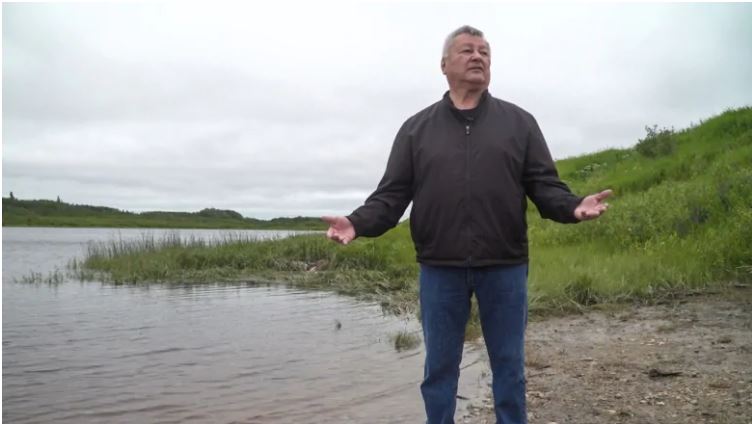Area residents said they worry that the lakes in the area and municipal water will be affected by the plant. "There is no discharge from the factory whatsoever. As a matter of fact, they’re not even hooked up to sewage," said Chirico. "So there’s no effluent that will be discharged. They have their separate bed, which is inspected, which must be tested, all of these types of things." No one from IPC was made available for an interview with CTV News, but the company president issued a statement. "The North Bay IPC facility boasts state-of-the-art processes that are entirely enclosed and fully recyclable, resulting in zero environmental impact," the statement reads in part. "No water from our manufacturing process is discharged into any lakes, streams or other bodies of water. Additionally, no material waste is produced during the process."
Here's what could happen if the Canadian government classifies 'forever chemicals' together
"These chemicals don't get bound up by soils and in the bottom of lakes and oceans. They stay in the water. That means they circulate around, and it also means that these chemicals get into our drinking water," Diamond told CTVNews.ca in an interview earlier this year. The federal government is looking into how to regulate the chemicals, considering an approach of putting PFAS into new classes, different from the individual classification now.
Chemicals are forever: a new factory opens near Lake Nipissing, where water is already contaminated
Local news coverage of the opening has been sparse, mostly touting that the plant will bring economic benefits, including up to 35 new jobs to a town with an unemployment rate more than double the national average. Less has been said publicly about the company’s plans to manufacture — or perhaps just use, depending which Industrial Plastics employee is speaking — polytetrafluoroethylene (PTFE), a Teflon-like product that falls into a larger group of chemicals called per- and polyfluoroalkyl substances (PFAS).
How solar-powered technology could enhance rainwater harvesting in Mexico
Research from a U of T Engineering team could help support household access to safe drinking water in low and middle-income communities by adopting solar-powered ultraviolet (UV) LED illumination to treat water in Mexico’s rainwater harvesting systems. The team includes Mistelle Haughton (CivMin MASc candidate), Karlye Wong (CivMin PhD candidate) and Professor Ron Hofmann (CivMin). Together, they are among a handful of researchers focusing on the benefits of UV LEDs for water harvesting systems.
Ohio train derailment: Chemicals that ‘may be of health concern’ found in East Palestine
An analysis of Environmental Protection Agency (EPA) data by Texas A&M University has found elevated levels of nine chemicals that “may be of health concern” to residents of East Palestine, Ohio. The small town of 5,000 played host to a nightmarish scenario early this month when a train carrying hazardous materials crashed, leaking toxins into the soil, water and air.
Corner Brook mayor says water treatment costs rose about 40% last year
The City of Corner Brook says it's paying significantly more for water treatment than it did a year ago. Mayor Jim Parsons says the cost of the multiple chemicals used in the treatment process have all increased by about 40 per cent compared with last year. Some have increased by more than 50 per cent. "We're used to seeing price increases throughout the COVID thing. We've noticed the supply is not where it used to be, so prices go up," said Parsons in a recent interview.
The Dangers of Fracking in Canadian Wells
Fracking is a process of drilling and injecting fluid into the ground at a high pressure in order to fracture shale rocks and release natural gas inside. Although fracking has been used in the U.S. since the 1950s, it was not until recently that this process made its way up to Canada. Currently, there is a moratorium on fracking in Quebec, but this process is still occurring in many other parts of the country. Fracking has been shown to have a number of negative environmental impacts, including water contamination, air pollution, and noise pollution. In addition, fracking can also lead to earthquakes. For these reasons, it is important for Canadians to be aware of the dangers of fracking so that they can make informed decisions about whether or not to support this process.
Nova Scotia Health to pause testing water for chemicals in province's central zone
Nova Scotia Health says it will pause testing water for chemicals in the province's central zone beginning Monday due to a worldwide shortage of an unnamed chemical component used in the testing. The health authority said it will reassess the situation in three to four weeks. According to the province, more than 40 per cent of Nova Scotia households get their drinking water from wells. It encourages regular testing.
Judge bars pesticide spraying in Miramichi Lake until hearing
A judge has barred a group from spraying a chemical in the Miramichi Lake area until a lawsuit filed by local cottage owners can be heard. Spraying of rotenone, a pesticide and piscicide, was scheduled Wednesday to eradicate invasive smallmouth bass, according to court documents. On Tuesday, Justice Terrence Morrison made an order preventing any spraying until the lawsuit objecting to it is heard on Aug. 17.
US cruise ships using Canada as a ‘toilet bowl’ for polluted waste
From the comfort of cruise ships, a typical trip to Alaska offers magnificent views of glaciers and untamed national parks, and visits to quaint seaside towns. For years, these draws have made cruises to Alaska the most booked US holiday. But the journey to those pristine areas, which involves sailing along Canada’s west coast for two or three days, is leaving behind a trail of toxic waste, including within marine protected areas (MPAs), according to new research.
Fighting Floods, or Living with Water?
Every year, Lower Mainland residents prepare for the Big One. The region is located near the Cascadia subduction zone, and it’s only a matter of time before a megathrust earthquake hits. During the annual Oct. 20 ShakeOut event in southwest B.C., school kids practice diving under desks. People ready their workplaces with emergency kits and evacuation plans. But there’s another type of disaster that we’re reminded about less often: a major flood.
Road traffic isn’t just bad for the air – it's potentially a major source of water pollution: U of T study
Heavy traffic is often associated with air pollution but a new study from the University of Toronto suggests it’s a major contributor to water pollution, too. The study, published in the journal Environmental Research Letters, found that chemicals commonly used in vehicle fluids, tires and paints were much higher in rivers next to roads with heavy traffic. “We found a strong relationship between traffic and the concentration of these chemicals,” says Tife Awonaike, a recent PhD graduate from the department of physical and environmental science at U of T Scarborough who is lead author of the study.
Islander aims Clearflo clean drinking water system at Canada’s remote communities
“We can provide access to safe, clean water where it’s lacking in third world countries,” Haughton said. “Strangely enough, we have that situation right here in our backyard in Canada, which is surprising and disappointing.” Worth $300,000, the mobile system is designed to sit inside a 10-foot shipping container. It uses natural filters to remove bacteria, metals and chemicals. It can produce 50,000 litres of water in a day, via solar energy, which is enough for 500-2,000 people, depending on the location.
First Nations workers in Sask. sacrifice wages, vacation to run underfunded water systems
Rebecca Zagozewski is the executive director of the Saskatchewan First Nations Water Association, a non-profit organization that works to build First Nations’ capacity to take care and control of their own water services. She says recruitment and retention of water treatment plant operators is a “real problem” on Saskatchewan First Nations, largely because they often can’t pay operators competitive wages.
Government of Canada launches consultation process for new Canada Water Agency
“Through the Canada Water Agency, our government is looking to strengthen collaboration between the federal government, the provinces, territories, Indigenous peoples and other partners to find the best ways to safeguard our freshwater consultations are an important part of this process and I look forward to input from Canadians,” Terry Duguid said in a statement. Mr. Duguid is Parliamentary Secretary to Minister Wilkinson and has been key in the development process. The discussion paper, ‘Toward the Creation of a Canada Water Agency,’ presents key issues and provides an overview of the federal government’s existing activities to enhance freshwater management, and a virtual national freshwater policy forum is planned for January 27 and 28. A series of regional forums will be held in February that will provide additional opportunities to participate in consultations. The discussion paper and additional information can be found at placespeak.ca. Comments can be submitted until March 1.
First Nations communities pursue clean drinking water through the courts
This time of year, with the temperature plunging below -20 C, a snowmobile and an ice chisel are required tools for anyone in Tataskweyak Cree Nation in need of fresh water. There’s the bottled stuff, trucked into town courtesy of the federal government, but the weekly shipment of 1,500 cases is only sufficient to meet basic consumption needs. For cleaning, cooking and basic hygiene water, many residents need a supplementary source. And rather than use their tainted tap water, they follow a snowmobile trail several kilometres to Assean Lake, pails in hand.
Potential damage is being downplayed in latest Alberta oil pipeline leak
Less than two months after a spill at an oil pipeline dumped 900,000 litres of contaminated water–so called “produced water”–in northwestern Alberta, there’s been another spill in the oil-rich province. The latest spill, reported at 2 p.m on Christmas Day by a local landowner, occurred near Drayton Valley, a community about 130 kilometres southwest of Edmonton, the province’s capital city. Drayton Valley was the site of a spill–the result of a ruptured pipeline–that dumped 40,000 litres of crude oil into a local creek in August, 2019.
Former Neskantaga contractor accused of cutting corners in other First Nations
“They cut corners every day, every day,” said Justin Gee, vice-president of First Nations Engineering Services Ltd. Gee said he encountered these recurring problems while overseeing the work of a construction firm, Kingdom Construction Limited (KCL), building a water treatment plant 10 years ago in Wasauksing First Nation, along the eastern shore of Georgian Bay, about 250 kilometres north of Toronto. “You have to be on them every step of the way,” said Gee, who was the contract administrator on the project. “You can’t leave them on their own.”
Northern Alberta hamlet evacuating residents after water plant shut down
Leadership in a northern Alberta hamlet will be evacuating about 150 people after a chemical mix-up at the community's water plant. Vern Janvier, chief of the Prairie Chipewyan First Nation, said the First Nation decided on Monday to offer residents who rely on piped water the option of leaving their homes. There are 107 houses on the system, and Janvier said from one to six people live in each house. He anticipates there will be between 150 and 200 evacuees.
8-10 years to fix Attawapiskat water problems, chief estimates
It's been one month since Attawapiskat First Nation declared a state of emergency over its poor water quality. The measure was taken in the northern Ontario community due to high levels of trihalomethane (THMs) and haloacetic acids (HAAs) in the water the residents use for bathing and cooking. The fly-in community has a separate system for its drinking water.




















